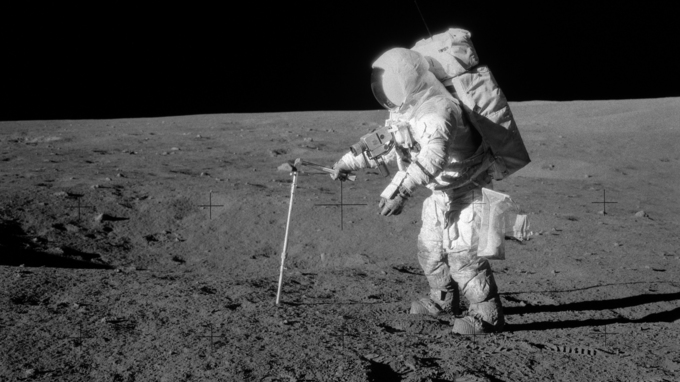Bestätigung für Sternenexplosion in der Nähe unseres Sonnensystems
Supernova-Eisen auch auf dem Mond gefunden
2016-04-14 – Nachrichten aus dem Physik-Department
Ein sterbender Stern beendet sein Leben mit einer gewaltigen Explosion. Einen großen Teil seiner Materie, vor allem die während der Explosion neu entstandenen chemischen Elemente, schleudert er dabei ins Weltall.
Eine oder mehrere solcher Supernovae müssen sich vor rund zwei Millionen Jahren in der Nähe des Sonnensystems ereignet haben. Darauf deutete bereits auf der Erde die erhöhte Konzentration des Eisen-Isotops Fe-60 hin, das in einer Tiefseekruste des Pazifischen Ozeans und auch in Meeressedimenten gefunden wurde.
Die Indizien sind stark: Das radioaktive Fe-60 entsteht fast ausschließlich in Sternenexplosionen. Und weil seine Halbwertszeit von 2,62 Millionen Jahren im Vergleich zum Alter unseres Sonnensystems kurz ist, sollte radioaktives Fe-60 aus der Zeit der Bildung des Sonnensystems auf der Erde längst in stabile Elemente zerfallen und damit nicht mehr vorhanden sein.
Mondproben von den Apollo-Missionen
Nun erhält diese Supernova-Hypothese, zu der erstmalig im Jahr 1999 von Forschern der Technischen Universität München (TUM) Hinweise in einer Tiefseekruste gefunden wurden, weitere Bestätigung: Physiker der TUM und Kollegen aus den USA konnten auch in Bodenproben des Mondes eine ungewöhnlich hohe Ansammlung von Fe-60 nachweisen.
Die Proben stammen von den Flügen der Apollo-Missionen 12, 15 und 16, die zwischen 1969 und 1972 auf dem Mond gelandet waren und von dort Material zur Erde gebracht hatten.
Zwar kann Fe-60 auf dem Mond auch durch das Bombardement mit kosmischen Teilchen entstehen, denn diese Teilchen zerschellen nicht wie auf der Erde an den Luftmolekülen der Atmosphäre, sondern prasseln direkt auf die Mondoberfläche und können so zur Spaltung von Elementen führen. „Aber diese Quelle kann nur einen sehr kleinen Anteil des Vorkommens an Fe-60 erklären“, erklärt Dr. Gunther Korschinek von der TUM, der auch Wissenschaftler des Exzellenzclusters Universe ist.
Ablagerung von frisch produziertem Sternenmaterial
„Wir gehen daher davon aus, dass das Fe-60 in beiden Funden, Mond und Erde, denselben Ursprung hat: es handelt sich um die Ablagerungen von frisch erzeugtem Sternenmaterial, das in einer oder mehreren Supernovae produziert wurde“, sagt Korschinek.
Weil der Mond ein besseres kosmisches Archiv als die Erde darstellt, konnten die Wissenschaftler auch erstmals eine Obergrenze für den Fluss an Fe-60 angeben, der den Mond erreicht haben muss. Daraus können die Forscher unter anderem auf die damalige Entfernung zum Supernova-Ereignis schließen: „Der gemessene Fe-60 Fluss entspricht einer Supernova in einem Abstand von etwa 300 Lichtjahren“, sagt Korschinek. „Dieser Wert stimmt gut überein mit einer kürzlich in Nature publizierten theoretischen Abschätzung.“
Die Proben des Mondes wurden am hochempfindlichen Beschleuniger-Massenspektrometer des Maier-Leibnitz-Laboratoriums in Garching untersucht. Neben den Physikern der TUM waren an der Veröffentlichung auch Wissenschaftler der Rutgers University, USA, und des Planetary Science Institute in Los Alamos, USA, beteiligt. Finanziell wurde die Arbeit durch die Deutsche Forschungsgemeinschaft über den Exzellenzcluster Universe unterstützt.
Veröffentlichung
Verwandte Meldungen
- 5 Jahre nach Fukushima – 2016-03-11
- Überraschende Erkenntnisse über die Entstehung der Elemente – 2015-01-27
Links
- Arbeitsgruppe Experimentelle Astroteilchenphysik
- Arbeitsgruppe Nukleare Astrophysik
- APS Synopsis (Englisch): Supernova Footprint on the Moon
Kontakt
- Dr. Gunther Korschinek
- Technische Universität MünchenJames-Franck-Str. 185748 GarchingTel.: +49 89 289-14257E-Mail: korschin@tum.de
- Dr. Thomas Faestermann
- Technische Universität MünchenJames-Franck-Str. 185748 GarchingTel.: +49 89 289-12438E-Mail: thomas.faestermann@ph.tum.de
